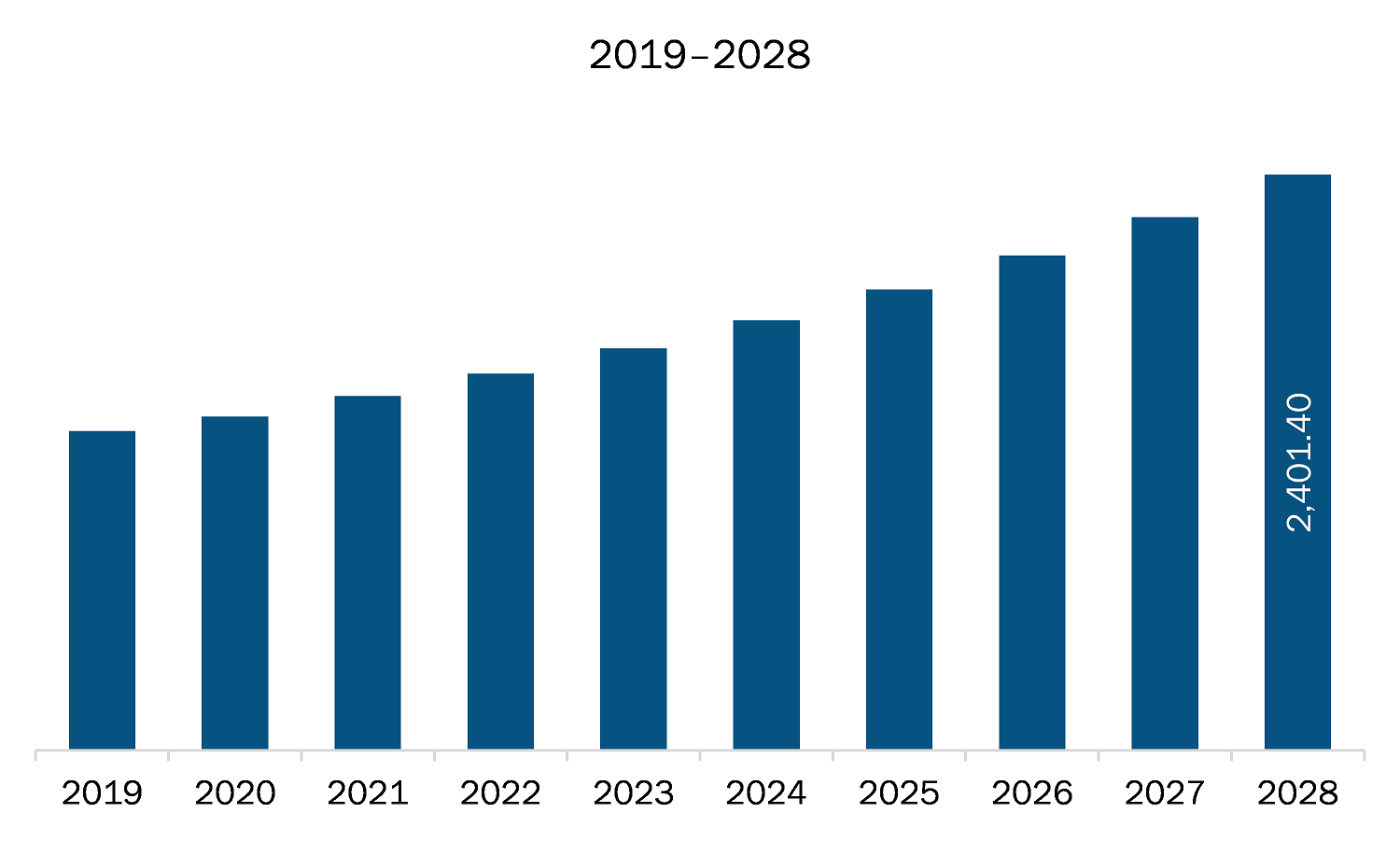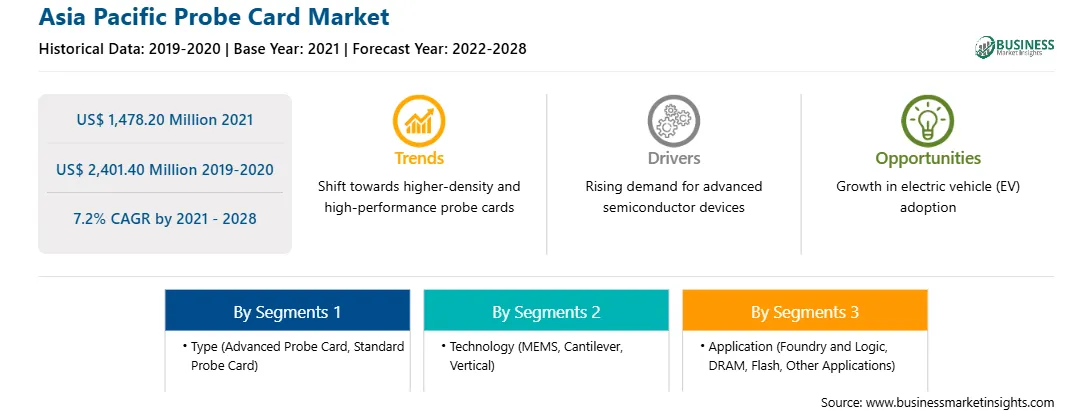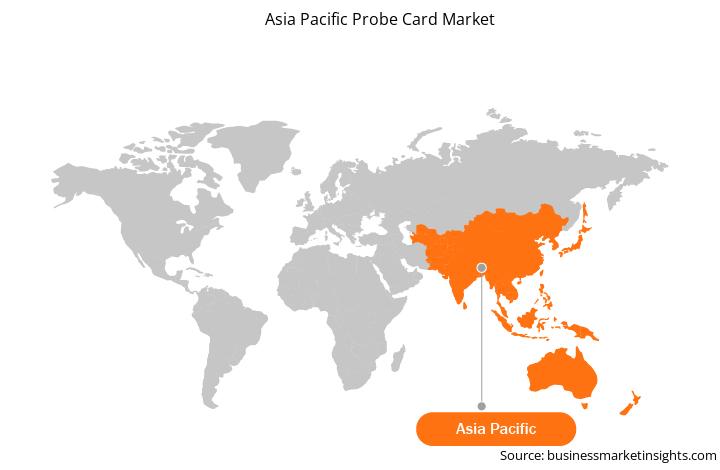Asia Pacific comprises the largest and most dynamic economies such as China, India, Japan, Australia, and South Korea. Taiwan, China, and Japan are the leading semiconductor manufacturing countries in Asia Pacific. The rising disposable income in developing countries such as India and China, is leading to a large client base for high-tech consumer electronics such as smart wearables, smartphones, and electric vehicles. This factor is expected to drive the probe card market in the region. China is a leading manufacturing hub for the IC packaging technology-based products, while Taiwan, South Korea, and Japan are also significant contributors to the regional market growth. Many of the Asia Pacific countries are characterized by the mass production of electronic devices required for consumer electronics, automotive components, telecommunication devices, and other industrial machineries. Also, building 5G infrastructure is the major factor driving the growth of the APAC probe card market.
The COVID-19 that emerged in China has affected several neighboring countries such as India, South Korea, and Japan, among others. China and India are the most prominent manufacturing hub in the region and have an enhanced focus on industrialization. The growth of the manufacturing industry has been hampered due to lockdown but soon expected to recover the development by enhancing the production capabilities in the second half of the year 2021. The imposition of a ban on commercial activities has disrupted the industrial supply chains in Asia Pacific region, leading to raw material shortages. Further, the demand for advanced electronics such as a smartwatches, smart wearables, and healthcare machines has risen significantly. Also, the development of new airports is rising defense expenditure of countries such as China and India; this is likely to provide growth opportunities to the market due to more uses of IC chips. Moreover, companies in Asia Pacific have restructured their capabilities by adopting various strategies such as product enhancements, partnerships, and acquisitions.

Strategic insights for the Asia Pacific Probe Card provides data-driven analysis of the industry landscape, including current trends, key players, and regional nuances. These insights offer actionable recommendations, enabling readers to differentiate themselves from competitors by identifying untapped segments or developing unique value propositions. Leveraging data analytics, these insights help industry players anticipate the market shifts, whether investors, manufacturers, or other stakeholders. A future-oriented perspective is essential, helping stakeholders anticipate market shifts and position themselves for long-term success in this dynamic region. Ultimately, effective strategic insights empower readers to make informed decisions that drive profitability and achieve their business objectives within the market.

| Report Attribute | Details |
|---|---|
| Market size in 2021 | US$ 1,478.20 Million |
| Market Size by 2028 | US$ 2,401.40 Million |
| Global CAGR (2021 - 2028) | 7.2% |
| Historical Data | 2019-2020 |
| Forecast period | 2022-2028 |
| Segments Covered |
By Type
|
| Regions and Countries Covered | Asia-Pacific
|
| Market leaders and key company profiles |
The geographic scope of the Asia Pacific Probe Card refers to the specific areas in which a business operates and competes. Understanding local distinctions, such as diverse consumer preferences (e.g., demand for specific plug types or battery backup durations), varying economic conditions, and regulatory environments, is crucial for tailoring strategies to specific markets. Businesses can expand their reach by identifying underserved areas or adapting their offerings to meet local demands. A clear market focus allows for more effective resource allocation, targeted marketing campaigns, and better positioning against local competitors, ultimately driving growth in those targeted areas.

The probe card market in APAC is expected to grow from US$ 1,478.20 million in 2021 to US$ 2,401.40 million by 2028; it is estimated to grow at a CAGR of 7.2% from 2021 to 2028. Increase in the use of smartphones, desktops, digital cameras, tablets, laptops, hard disks, and televisions, among others, and continuous development and introduction of new technologies have been triggering evolution in the consumer electronics industry. The rise in demand for consumer electronics is mainly credited to the emergence of smart devices and IoT, growing adoption of tablets, and surge in demand for devices with large screens. The surge in consumer electronics demand is driving the growth of the semiconductor manufacturing businesses, as consumer electronics is one of the industries that highly depend on the semiconductor industry. Changes in trends related to chip sizes and growing preference for innovative architecture in various electronic devices have boosted semiconductor demand. The elevating scale of integrated circuit (IC) chips manufacturing has led to the surge in demand for electronics testing, which is propelling the requirement of probe cards. Additionally, the introduction of advanced technologies in semiconductor manufacturing equipment, such as AI and IoT, would accelerate their adoption in fabrication facilities. Furthermore, the rising demand for silicon-based sensors for IoT devices, expanding presence of chip industries in emerging countries, and rise in the number of data centers and servers are the factors that help boost the performance of the semiconductor industry. These factors, in turn, would continue to boost the demand for probe cards in the coming years.
The APAC probe card market has been analyzed based on type, technology, application, and country. Based on type, the probe card market is segmented into advanced probe card and standard probe card. The advanced probe card segment dominated the market in the year 2020 and is expected to be the fastest growing during forecast period. Based on technology, the probe card market is segmented into MEMS, cantilever, and vertical. The MEMS segment dominated the market in the year 2020 and is expected to be the fastest growing during forecast period. Moreover, based on application, probe card market is segmented into foundry and logic, DRAM, flash, and others. The foundry and logic segment dominated the market in the year 2020 and is expected to be the fastest growing during forecast period.
A few major primary and secondary sources referred to for preparing this report on the probe card market in APAC are company websites, annual reports, financial reports, national government documents, and statistical database, among others. Major companies listed in the report are FEINMETALL GmbH; FormFactor, Inc.; Fujitsu; Japan Electronic Materials Corporation; Korea Instrument Co., Ltd.; Micronics Japan Co., Ltd.; MPI Corporation; SV Probe; and Technoprobe S.p.A. among others.
The Asia Pacific Probe Card Market is valued at US$ 1,478.20 Million in 2021, it is projected to reach US$ 2,401.40 Million by 2028.
As per our report Asia Pacific Probe Card Market, the market size is valued at US$ 1,478.20 Million in 2021, projecting it to reach US$ 2,401.40 Million by 2028. This translates to a CAGR of approximately 7.2% during the forecast period.
The Asia Pacific Probe Card Market report typically cover these key segments-
The historic period, base year, and forecast period can vary slightly depending on the specific market research report. However, for the Asia Pacific Probe Card Market report:
The Asia Pacific Probe Card Market is populated by several key players, each contributing to its growth and innovation. Some of the major players include:
The Asia Pacific Probe Card Market report is valuable for diverse stakeholders, including:
Essentially, anyone involved in or considering involvement in the Asia Pacific Probe Card Market value chain can benefit from the information contained in a comprehensive market report.